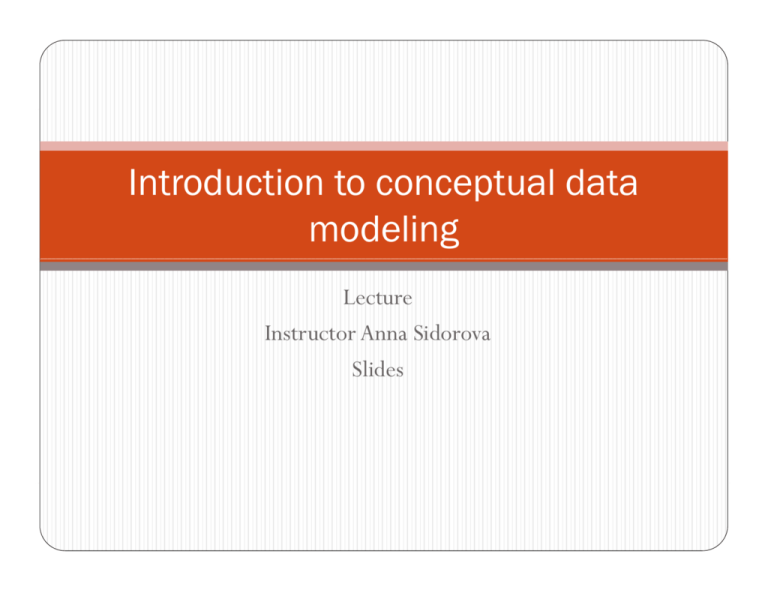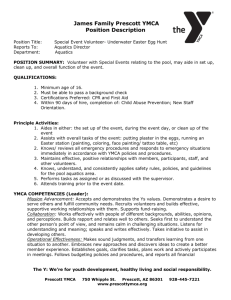Introduction to conceptual data modeling
advertisement

Introduction to conceptual data modeling Lecture Instructor Anna Sidorova Slides Agenda g Project Proposal and HW 1 discussion Review R off ERD elements l ERD exercise Enhanced ERDs Weak entities and indentifying relationships Subtype/ supertype relationships Entityy clusteringg Oracle Designer demonstration – hands on next class 2 Next few classes Feb 14 – Introduction to relational DB, Oracle Designer hands on practice in the lab HW 1 is due in class Feb F b 21 – Relational R l ti l DB DB, Normalization N li ti Project Proposal is due Feb 28 – Review for the midterm exam HW 2 is due March 7 – Midterm exam 3 Based on Hoffer, Prescott and Topi Modern Database Management, (c) Prentice Hall 2009 HW1 Draw ERD models for the following descriptions: Ch. 2, problems 20, 23 Ch. 3, problems 12, 15 4 Based on Hoffer, Prescott and Topi Modern Database Management, (c) Prentice Hall 2009 Project Proposal Title page and the table of contents Executive summary Problem description including your understanding of the 5 ffunctionall area The goal and benefits of the project Th scope off th The the project j t Your approach to the project Team composition and relevant experiences Project Plan Based on Hoffer, Prescott and Topi Modern Database Management, (c) Prentice Hall 2009 Last Class DB Schemas External – what the users see Conceptual p – business view,, independent p of technology Internal Logical Physical 6 Based on Hoffer, Prescott and Topi Modern Database Management, (c) Prentice Hall 2009 Last class Conceptual data modeling Representing data in the organization and related business rules using entity-relationship diagrams ERD elements Entity – business objects, things Attributes – properties of things Relationships – associations between things 7 Based on Hoffer, Prescott and Topi Modern Database Management, (c) Prentice Hall 2009 ERD Elements BCIS 4610, Spring 2010 An ERD Example BCIS 4610, Spring 2010 Reading ERD BCIS 4610, Spring 2010 What Should an Entityy Be? SHOULD BE: An object that will have many instances in the database An object that will be composed of multiple attributes An object that we are trying to model SHOULD NOT BE: BE A user of the database system An output of the database system (e.g., g a report) Based on Hoffer, Prescott and Topi Modern 11Management, (c) Prentice Hall 2009 Database Figure 3-4 Example of inappropriate entities System user System output Inappropriate pp p entities Appropriate entities 12 on Hoffer, Prescott and Topi Modern Database Management, (c) Prentice Hall 2009 Based Att ib t Attributes Attribute Attribute––pproperty p y or characteristic of an entityy or relationship type Classifications of attributes: Required versus Optional Attributes Simple versus Composite Attribute Single Si l -Valued SingleV l d versus Multivalued M lti l d Attribute Att ib t Stored versus Derived Attributes Identifier Attributes Based on Hoffer, Prescott and Topi Modern 13Management, (c) Prentice Hall 2009 Database Figure 3-7 A composite attribute An attribute broken into component parts Figure 3-8 Entity with multivalued attribute (Skill) and derived attribute (Years_Employed) Multivalued an employee can have more than one skill Based on Hoffer, Prescott and Topi Modern 14Management, (c) Prentice Hall 2009 Database Derived from date employed and current date Id tifi Identifiers (Keys) (K ) Identifier (Key) (Key)– –an attribute (or combination of attributes) ib ) that h uniquely i l id identifies ifi iindividual di id l iinstances off an entity type Simple versus Composite Identifier Candidate Identifier Identifier– –an attribute that could be a key…satisfies y the requirements q for beingg an identifier 15 on Hoffer, Prescott and Topi Modern Database Management, (c) Prentice Hall 2009 Based Ch Characteristics t i ti off Identifiers Id tifi Will not change g in value Will not be null No intelligent g identifiers (e.g., ( g , containingg locations or people that might change) Substitute new, simple keys for long, g composite keys 16 on Hoffer, Prescott and Topi Modern Database Management, (c) Prentice Hall 2009 Based Figure 3-9 Simple and composite identifier attributes The identifier is boldfaced and underlined Based on Hoffer, Prescott and Topi Modern 17Management, (c) Prentice Hall 2009 Database Relationships Associations between entities Relationships are characterized by: Cardinalityy Maximum Minimum (also referred to as modality or optionality optionality)) Degree (some use the term degree to refer to cardinality) cardinalit ) Unary Binary Ternary Based on Hoffer, Prescott and Topi Modern 18Management, (c) Prentice Hall 2009 Database Figure g 3-10 Relationship p types yp and instances a) Relationship type b) Relationship instances Based on Hoffer, Prescott and Topi Modern 19Management, (c) Prentice Hall 2009 Database D g Degree off R Relationships l ti hi Degree of a relationship is the number of entity types that participate ti i t iin it Unary Relationship Binaryy Relationship p Ternary Relationship Based on Hoffer, Prescott and Topi Modern 20Management, (c) Prentice Hall 2009 Database Degree of relationships – from Figure 3-2 One entity related to another th off th the same entity type Entities of two different types related to each other h Based on Hoffer, Prescott and Topi Modern 21Management, (c) Prentice Hall 2009 Database Entities of three different types related to each other Figure 3-12 Examples of relationships of different degrees a) Unary relationships Based on Hoffer, Prescott and Topi Modern 22Management, (c) Prentice Hall 2009 Database Figure 3-12 Examples of relationships of different degrees (cont.) b) Binary relationships Based on Hoffer, Prescott and Topi Modern 23Management, (c) Prentice Hall 2009 Database Figure 3-12 Examples of relationships of different degrees (cont.) c) Ternary relationship Note: a relationship can have attributes of its own Based on Hoffer, Prescott and Topi Modern 24Management, (c) Prentice Hall 2009 Database Cardinality of a relationship Maximum The Th maximum number b off instances off entity type A can that h can simultaneously have a relationship with each instance of entity type B Can be 1, or many Example: How many students (maximum) can be enrolled in a course? How manyy courses ((maximum)) can each student take? Minimum The minimum number of instances of entity type A can that can simultaneously i lt l have h a relationship l ti hi with ith eachh iinstance t off entity tit ttype B Can be 0 (optional) or 1 (mandatory) 25 Based on Hoffer, Prescott and Topi Modern Database Management, (c) Prentice Hall 2009 Cardinality of Relationships One One--to to--One Each h entity in the h relationship l h willll hhave exactly l one related l d entity One One--to to--Manyy An entity on one side of the relationship can have many related entities, but an entity on the other side will have a maximum of one related entity Many Many--to to--Many Entities on both sides of the relationship can have many related entities on the h other h side d Based on Hoffer, Prescott and Topi Modern Database Management, (c) Prentice Hall 26 2009 Figure 3-17 Examples of cardinality constraints a)) M Mandatory d t cardinalities di liti A patient ti t history hi t is i recorded for one and only one patient Based on Hoffer, Prescott and Topi Modern 27Management, (c) Prentice Hall 2009 Database A patient must have recorded at least one sto y, and a d ca can have a e history, many Figure 3-17 Examples of cardinality constraints a)) M Mandatory d t cardinalities di liti A patient ti t history hi t is i recorded for one and only one patient Based on Hoffer, Prescott and Topi Modern 28Management, (c) Prentice Hall 2009 Database A patient must have recorded at least one sto y, and a d ca can have a e history, many Figure 3-17 Examples of cardinality constraints (cont.) b) One optional, optional one mandatory A project must be assigned to at least one employee, and may be assigned to many Based on Hoffer, Prescott and Topi Modern 29Management, (c) Prentice Hall 2009 Database An employee can be assigned to any number of projects, or may not be assigned to any at all Figure 3-17 Examples of cardinality constraints (cont.) c)) Optional O ti l cardinalities di liti A person is married to at most one other person, or may not be married at all Based on Hoffer, Prescott and Topi Modern 30Management, (c) Prentice Hall 2009 Database Figure 3-21 Examples of multiple relationships a) Employees and departments Entities can be related to one another in more than one way Based on Hoffer, Prescott and Topi Modern 31Management, (c) Prentice Hall 2009 Database Figure 3-21 Examples of multiple relationships (cont.) b) Professors and courses (fixed lower limit constraint) Here, min H i cardinality constraint is 2 Based on Hoffer, Prescott and Topi Modern 32Management, (c) Prentice Hall 2009 Database Oracle Notations CUSTOMER # CUST_NO STUDENT # SID places is_placed is enrolled enrolls BCIS 4610, Spring 2010 ORDER # ORDER_NO COURSE1 Based on Hoffer, Prescott and Topi Modern 34Management, (c) Prentice Hall 2009 Database Let’s practice As a part of its project management database, the company wants to store information about resources (employees), projects and bookings. For each employee, the following information is stored: Employee ID, First and Last name, Rank, and billing rate. Employees are organized into solution sets, each solution set has a head of the solution set, who is the resource owner for all employees in that SS. For each solution set we record the SS ID and the SS name. For scheduling purposes, we want to store information about the head of each solution set, and about assignment of employees to solution sets. An employee can belong to only l one solution l i set. The scheduling system also stores information about projects. For each project, the following information is stored: Project ID, Status, Location and Client name. 35 As a part off the A h scheduling h d li system, we store information i f i about b bookings. b ki When Wh a bbooking ki iis requested for an employee, the employee is scheduled to work on a particular project, on a particular day for the specified amount of time (10%-100%). So,for each booking we record date, % of time and current status. Based on Hoffer, Prescott and Topi Modern Database Management, (c) Prentice Hall 2009 Weak and associative entities Strong vs. Weak Entities, and Identifying Relationships Strongg entities exist independently of other types of entities has its own unique identifier identifier underlined with single line Weak k entity dependent on a strong entity (identifying owner)…cannot exist on its own does not have a unique identifier (only a partial identifier) partial ti l identifier id tifi underlined d li d with ith double d bl line li entity box has double line Identifying relationship links strong entities to weak eak entities 37 Identifying relationship (Figure 3-5) Strong entity 38 Weak entity Associative Entities An entity–has attributes A relationship– links entities together When should a relationship with attributes instead be an associative entity? All relationships for the associative entity should be many The associative entity could have meaning independent of the other entities The associative entity preferably has a unique identifier, and should also have other attributes The associative entity may participate in other relationships other than the entities of the associated relationship Ternary relationships should be converted to associative entities Based on Hoffer, Prescott and Topi Modern Database Management, (c) Prentice Hall 39 2009 Figure g 3-11a A binaryy relationship p with an attribute Here, the date completed p attribute pertains p specifically p y to the employee’s completion of a course…it is an attribute of the relationship Based on Hoffer, Prescott and Topi Modern 40Management, (c) Prentice Hall 2009 Database Figure 3-11b An associative entity (CERTIFICATE) Associative entity is like a relationship with an attribute, but it is also considered to be an entity in its own right Note that the many-to-many cardinality between entities in Figure 3-11a has been replaced by two one-to-many relationships with the associative entity Based on Hoffer, Prescott and Topi Modern 41Management, (c) Prentice Hall 2009 Database Figure 3-13c An associative entity – bill of materials structure This could just be a relationship with attributes…it’s a judgment call Based on Hoffer, Prescott and Topi Modern 42Management, (c) Prentice Hall 2009 Database Figure 3-18 3 18 Ternary relationship as an associative entity Based on Hoffer, Prescott and Topi Modern 43Management, (c) Prentice Hall 2009 Database Alternative notations for associative entities titi PO_LINE Qty P_ORDER PO_No MATERIAL Material_No PO_LINE is identified by: PO_No Material_No _ P_ORDER # ORDER ORDER_NO NO includes f from PO_LINE o QTY BCIS 4610, Spring 2010 is_in i l d includes MATERIAL # MATERIAL MATERIAL_NO NO Let’s practice Ch. 2 problem 15 a, d, e 45 Based on Hoffer, Prescott and Topi Modern Database Management, (c) Prentice Hall 2009 Subtype/supertype relationships Supertypes and Subtypes Subtype: A subgrouping of the entities in an entity type that has attributes distinct from those in other subgroupings Supertype Supertype:: A generic entity type that has a relationship with one or more subtypes bt Attribute Inheritance: Subtype yp entities inherit values of all attributes of the supertype p yp An instance of a subtype is also an instance of the supertype 47 Figure 4-1 Basic notation for supertype/subtype notation a) EER notation Based on Hoffer, Prescott and Topi Modern 48 Database Management, (c) Prentice Hall 2009 Figure 4-1 Basic notation for supertype/subtype notation (cont.) b) Microsoft Visio Notation Different modeling tools may have different notation for the same modeling constructs 49 Figure 4-2 Employee supertype with three subtypes All employee subtypes will have emp nbr, name, address, and date hired Each employee subtype will also have its own attributes Based on Hoffer, Prescott and Topi Modern 50 Database Management, (c) Prentice Hall 2009 Relationships and Subtypes Relationships at the supertype level indicate that all subtypes will participate in the relationship The instances of a subtype may participate in a relationship unique to that subtype subtype. In this situation, situation the relationship is shown at the subtype level 51 Figure 4-3 Supertype/subtype relationships in a hospital Both outpatients and resident patients are cared for by a responsible physician Only resident patients are assigned to a bed Based on Hoffer, Prescott and Topi Modern 52 Database Management, (c) Prentice Hall 2009 Generalization and Specialization Generalization: The process of defining a more general entity type from a set of more specialized entity types. BOTTOMBOTTOM-UP Specialization: The process of defining one or more subtypes of the supertype and forming supertype supertype/subtype /subtype relationships. TOP TOP--DOWN 53 Figure 4-4 Example of generalization a) Three entity types: CAR, TRUCK, and MOTORCYCLE All these types yp of vehicles have common attributes 54 Figure 4-4 Example of generalization (cont.) b) Generalization to VEHICLE supertype So we put p the shared attributes in a supertype Note: no subtype for motorcycle, since it has no unique attributes 55 Figure 4-5 Example of specialization a)) Entityy type yp PART Only applies to manufactured parts Applies only to purchased parts Based on Hoffer, Prescott and Topi Modern 56 Database Management, (c) Prentice Hall 2009 Figure 4-5 Example of specialization (cont.) b) Specialization to MANUFACTURED PART and PURCHASED PART Created 2 subtypes Note: multivalued attribute was replaced by an associative entity relationship to another entity Based on Hoffer, Prescott and Topi Modern 57 Database Management, (c) Prentice Hall 2009 Constraints in Supertype/ Supertype/ Completeness C l t Constraint C t i t Completeness Constraints: Constraints: Whether an instance of a supertype must also be a member of at least one subtype yp Total Specialization Rule:Yes (double line) Partial Specialization Rule: No (single line) 58 Figure 4-6 Examples of completeness constraints a) Total specialization rule A patient must be either an outpatient or a resident patient Based on Hoffer, Prescott and Topi Modern 59 Database Management, (c) Prentice Hall 2009 Figure 4-6 Examples of completeness constraints (cont.) b) Partial specialization rule A vehicle could be a car, a truck, or neither Based on Hoffer, Prescott and Topi Modern 60 Database Management, (c) Prentice Hall 2009 Constraints in Supertype: Supertype: Disjointness constraint t i t Disjointness Constraints: Whether an instance of a supertype may simultaneously i l l be b a member b off two t (or ( more)) subtypes bt Disjoint Rule: An instance of the supertype can be only ONE of the subtypes Overlap Rule: An instance of the supertype could be more than one of the subtypes 61 Figure 4-7 Examples of disjointness constraints a)) Disjoint j rule A patient can either be outpatient or resident, but not both Based on Hoffer, Prescott and Topi Modern 62 Database Management, (c) Prentice Hall 2009 Figure 4-7 Examples of disjointness constraints (cont.) b) Overlap rule A part may be both purchased and manufactured Based on Hoffer, Prescott and Topi Modern 63 Database Management, (c) Prentice Hall 2009 Constraints in Supertype/ Supertype/ Subtype Di i i t Discriminators Subtype Discriminator: Discriminator: An attribute of the supertype whose values determine the target subtype(s) Disjoint – a simple attribute with alternative values to indicate the possible subtypes Overlapping – a composite attribute whose subparts pertain to different subtypes. Each subpart contains a boolean value to indicate whether or not the instance belongs to the associated subtype 64 Figure 4-8 Introducing a subtype discriminator (disjoint rule) A simple attribute with different possible values i di ti the indicating th subtype Based on Hoffer, Prescott and Topi Modern 65 Database Management, (c) Prentice Hall 2009 Figure 4-9 Subtype discriminator (overlap rule) A composite attribute with sub-attributes indicating “yes” or “no” to determine whether it is of each subtype Based on Hoffer, Prescott and Topi Modern 66 Database Management, (c) Prentice Hall 2009 Figure 4-10 Example of supertype/subtype hierarchy Based on Hoffer, Prescott and Topi Modern 67 Database Management, (c) Prentice Hall 2009 How to show a subtype/supertype relationship l ti hi ACCOUNT1 # ACCT_NO o BALANCE o DATE_OPEN CHECKING_ACCT SAVINGS_ACCT o MONTHLY_FEE o INTEREST_RATE BCIS 4610, Spring 2010 Reading ERD BCIS 4610, Spring 2010 HW 1 discussion







